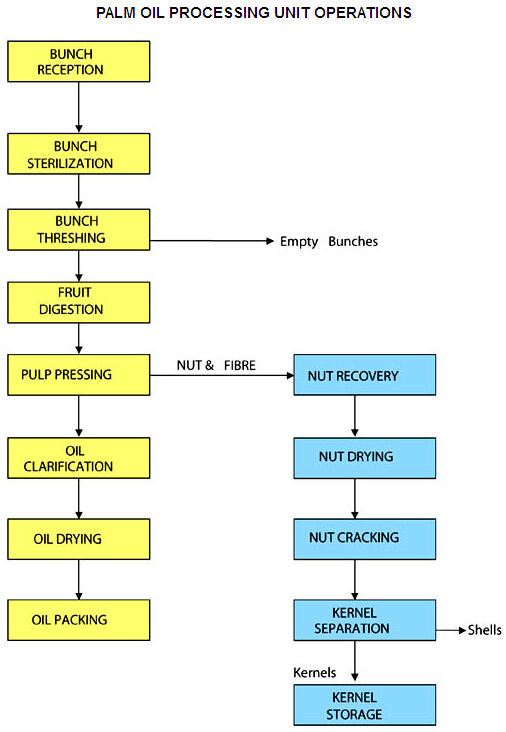In many disciplines, such as biochemistry, chemical and mechanical engineering, and the establishment of plantations, R&D work provides opportunities for large-scale fully mechanized processing, leading to the evolution of a series of processing steps, from harvesting oil palm fruit bunches to extracting. High-yield products meet acceptable quality standards in the international edible oil trade. The process of obtaining palm oil, in general, involves the pretreatment of fresh palm fruit bunches from the plantation, sterilization and threshing, and the crushing and pressing of mixed fruits to obtain crude palm oil. The crude oil is further purified, dried, stored and then exported.
Large-scale factories are required to produce palm oil throughout the entire stage of the international standard, usually processing fresh fruit bunches from 3-60 tons/hour. Large-scale equipment with mechanical processing systems (barrels and screw conveyors, pumps and pipes) and continuous operation, according to the availability of fresh fruit bunches. The boiler cooks fibers and shells to produce superheated steam, which is used to generate electricity through a turbine generator. Low-pressure steam is used from the steam turbine to heat the entire plant. Most of the processing operations are automatically controlled by laboratory control and routine sampling and analysis to ensure smooth and efficient operation.
The conversion of crude palm oil into refined oil involves removing the product's hydrolysis and oxidation, color and taste. After refining, the oil may be separated (classified) liquid and solid stages through the deformation field method (controlling cooling, crystallization, filtration), and the liquid part (olein) is more used as edible oil under tropical climate conditions, and it is successfully combined with More expensive peanuts, corn, and sunflower oil compete.
The oil extracted from palm kernels is usually extracted from palm oil and will often be processed in factories to process other oilseeds (such as peanuts, rapeseed, cottonseed, African shea fruit or dried coconut meat). The various stages in this process include grinding the inner core into small particles, heating (cooking), and extracting oil using oilseed cake or extracting solvent from the oil. Crude oil needs to be clarified in a filter press or sedimentation tank. Palm oil extraction is a mature industry, and international manufacturers can provide a large number of equipment that can handle from a few tons per hour to 10 kilograms per hour.
In addition to the development and installation of large-scale fully mechanized oil palm processing, small-scale villages and manual processing have continued to develop in Africa. The enterprise-wide production capacity ranges from 8 tons per day to several hundred kilograms per day of fresh fruit bunches, and crude oil is supplied to the domestic market.
Efforts to achieve mechanization and speed up the traditional manual procedures have been implemented by research institutions, development agencies, the private sector and engineering companies, but these activities are still relatively fragmented and uncoordinated. They generally focus on removing the monotonous and tedious grinding or mashing stage (digestion) and speeding up the efficiency of oil extraction. Small machines, electric mashers, have been developed in most African countries where oil palm is grown.
Palm oil processors of all sizes go through these stages of operation. They operate and interconnect material transfer mechanisms at each different mechanical level, making the system batch or continuous. The level of processing and the scale of operation are different in terms of product quality control, which can be achieved through the use of mechanized methods.
The flow chart is as follows:

Copyright © Henan Zhongxing Grain And Oil Machinery Co.,Ltd. All Rights Reserved. Powered by MetInfo